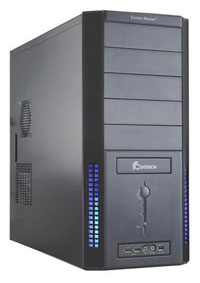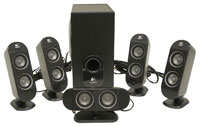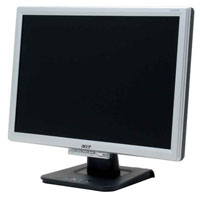Basic Configuration - Accessories
All of the components we've discussed so far tend to have more of an impact on overall system performance. What remains are the miscellaneous accessories that may not impact performance at all, but they do influence other areas of the computing environment. Personal preference will play a larger role in many of these components, so as always we would recommend people stick with what they like first and only branch out if you are looking to try something else. Most of the base selections can be used with any of the builds we will be putting together without any difficulty, and we will try to make note of any exceptions.
For optical storage, Blu-Ray and HD-DVD are still too expensive to warrant inclusion in a midrange computer, so we return to the venerable DVD+RW. Most companies now offer 18X burn speeds, which are barely faster than the old 16X maximum, and street prices bottom out at around $30. The LG GSAH22N includes all the standard features as well as 12X DVD-RAM support and works well with a variety of media, so it gets our recommendation. We're still waiting for reasonably priced SATA optical drives that can deliver similar overall quality, unfortunately.
 |
The computer case is one of the items that you will see a lot, but you really only have to work with it once or twice during the life of the typical computer (unless you upgrade frequently). Appearance is definitely an important consideration for many people, and what one person finds attractive another will find ugly or boring. Besides the appearance, the choice of case will also impact noise levels, cooling, and ease of installation. The cheapest cases tend to be made of thin steel, which gives them sharp edges internally and also makes them pretty flimsy. They will still suffice for most people, but we prefer slightly more expensive cases. Cooler Master has a large selection of reasonable midrange cases, and most of us find them to be easy to work with and reasonably attractive. Antec, In Win, Thermaltake, Apevia, Lian Li, and others offer alternatives worth considering, and if you are more budget minded the Rosewill brand is worth a look. We like cases that support 120mm fans (at least one) as they will typically offer better cooling with lower noise levels. Beyond that, remember to make sure your optical drive matches whatever case you choose.
 |
Of far more concern than the case is going to be the power supply you use, particularly in some of the upgraded midrange configurations. Getting a case with an included power supply will usually save you some money, and most power supplies rated at 350W or higher are sufficient for a midrange computer. Still, when you consider that you're spending over $1000 on all of the other components, we really hesitate to shave $40 or $50 off the total price by sticking with a low-end power supply. We've selected a reasonably priced 450W Fortron Source PSU as our basic recommendation, and that should be more than enough for any midrange computer, other than for serious overclocking. Fortron Source is a well-regarded PSU manufacturer, and they are often used as the basis of OEM power supplies. The only potential drawback of the AX450-PN is that it only has a 70% efficiency rating, but if you want a higher efficiency power supply you will have to spend more money. We're more concerned about power supply noise levels than efficiency, and while the two are related the 120mm fan used in the FSP helps to keep noise levels down. If you're willing to spend a bit more money and you want the best of both worlds - quiet and efficient - SeaSonic gets a strong recommendation. They tend to cost more for lower wattage ratings, but a SeaSonic S12-330 performs better than most other 400-450W power supplies. OCZ, Enermax, and several other companies also make some very good high-end power supplies, which we will discuss a bit further in the overclocking configuration, but SeaSonic remains one of the quietest (short of purchasing a fanless PSU).
 |
Keyboard, mouse, and speakers are three items where you can either go for the bare minimum cost and functionality, or you can spend a lot of money for extra features. We have selected what we feel are good options for all three areas, and it would be hard to find anything that's truly "better" without spending more money. Our performance configuration will include better speakers, but we didn't feel the need to upgrade the keyboard or mouse on any of the builds. If you want to get a wireless keyboard and mouse, our advice is to spend more money rather than less. The $30-$40 packages generally don't perform as well as we would like, so unless you absolutely want wireless input devices, we prefer to spend the extra money elsewhere.
 |
The last accessory is the display, and as we have said on many occasions we would much rather have a very nice display with a decent computer than to have an excellent computer with a lousy display. LCD prices have continued to drop, although even the cheapest 19" models still tend to cost just under $200. The 19" LCDs are still a good option, but for the extra money we would prefer to get a 20" LCD that comes with a higher resolution. Most of us also prefer widescreen LCDs these days, and although there are a few gaming titles that continue to cause irritation by not natively supporting widescreen resolutions, moving forward WS support should become commonplace. Outside of games, watching widescreen movies is definitely preferred, and we enjoy the extra screen width on the Windows desktop as well. Looking at the various 20" widescreen displays that are available, Acer once again has one of the best price/performance offerings. ViewSonic, BenQ, Samsung, and several other companies make similar LCDs, but they all cost a bit more and it is difficult to say that they actually look much better than the Acer model. For $230, most people will be very happy with the Acer AL2016W.
For the operating system, we selected Windows XP Media Center Edition 2005. It only costs slightly more than XP Home, and it allows you to upgrade to Vista Home Premium as we mentioned earlier. The DVR functionality may not be necessary, but it doesn't hurt either, and the only features that XP Pro adds (i.e. hard drive encryption) are not used by most people.














43 Comments
View All Comments
vailr - Friday, January 19, 2007 - link
Intel doesn't offer any compelling single core solutions right now.Consider the socket 775 Celeron D 356. When compared with an older Northwood P4 CPU of similar speed [~3.3 GHz at stock speed], it would seem to be a very good price/performance ratio upgrade. Tiger Direct has it for $50, after a $20 MIR. Combine with a VIA chip based motherboard, such as the ASRock Dual-VSTA or ECS P4M800 (or similar VIA board), which can also still re-use older DDR memory sticks and AGP video cards. Might even make an interesting basis for an Anandtech review, showing the "best bang for buck" upgrades, for a 2 or 3 year old system.
Some Celeron D 356 owners have also had excellent overclocking results (past 4 GHz), depending on the motherboard used.
mino - Saturday, January 20, 2007 - link
When compared with an older Northwood P4 CPUWell, the problem is A64 3200+ goes for $60.
$5 cheaper than 356...
LoneWolf15 - Friday, January 19, 2007 - link
At which resolutions? At 1920x1200, I think the 8800GTS would be the clear winner.
Also, I'd be interested to know how much difference there is between the Creative X-Fi ExtremeGamer, and the similarly priced (well, compared to your review, online I've seen it retailing slightly higher) X-Fi ExtremeAudio. The ExtremeAudio has the nicer gold-plated jacks; the ExtremeGamer actually is the first Creative card that I've seen that allows a user to plug in standard Intel-spec front panel audio. The card layouts are so different that I'm sure there has to be more differences than that; I'd like to know what those are.
uofahoefx - Friday, January 19, 2007 - link
If you are comparing price/performance I think the X2 4200+ would have been a better starting point. The performance difference between the 3800+ and E6300 is too significant to compare these systems.KorruptioN - Friday, January 19, 2007 - link
Whether or not the Rosewill 600W is really that much better than the Fotron Source 450W is debatableIt really is. I did some research as to who really was the OEM for this particular 600W Rosewill, and it turns out that the OEM is Solytech (the UL label on the PSU says E223918, Googling that brings me to http://www.jonnyguru.com/SMPS_UL.htm">this list, which then tells me Solytech). These guys are the new image for Deer electronics. If you've been around the hardware world for a while, you might know that Deer PSUs a few years back were notorious for being fire hazards, nothing better than doorstops. I still wouldn't trust them today. I think it was a poor choice for your guide.
For $71, you can get a much better PSU. Antec's http://www.newegg.com/Product/Product.asp?Item=N82...">TP3-430 is a good choice, and you'd be saving money. It's a Seasonic build, so you can be assured of high-efficiency, low-noise, and good power.
Operandi - Friday, January 19, 2007 - link
Your right Rosewill sucks. This guide would have been better served having recommended the entry level 450 watt Forton across the board since nothing here would be able to break 300 watts DC let alone 600 (assuming the Rosewill could even reach that point which itself is doubtful).About the Antec TP3; it is built buy Seasonic but it has also had corners cut to reach that price point -- it is not equal to Seasonic's own units. If you want Seasonic build quality get a Seasonic (or PCP&C Silencer or Crucial) if you want the best PSU to $$$ ratio it has to be this 400 watt http://www.ewiz.com/detail.php?name=PS-E5140GH">Enhance.
JarredWalton - Friday, January 19, 2007 - link
Despite the hard stance a lot of "informed enthusiasts" take on Rosewill, actual testing of a 500W unit by http://www.jonnyguru.com/review_details.php?id=48">JohnnyGuru.com turned in very favorable results. This is the same site that disliked the high ripple on the OCZ GameXStream 700W, FWIW (but still gave it a good review). I continue to think people are judging Rosewill without having actually tested/used any of their products. Are their QC standards as high as SeaSonic or some of the other top brands? Probably not, but outside of perhaps higher than normal DOA parts (which you just send back and get a new, working unit), they work very well in our experience.yyrkoon - Sunday, January 21, 2007 - link
Now, it is not the one being talked about here, but just yesterday, another IT friend of mine, got in his new thermaltake water cooled system case, and used a 350W Rosewill PSU to power up the water cooling portion (thankfully for him, his system board hadn't arrived yet), and while testing the cooling system a loud *pop* came from the the PSU, followed by a small 'billow' of smoke( he thinks he probably blew the top of a capacitor off, but didn't bother to look). The PSU continued to work for another 15 minutes according to him, but who knows what would have happened if this was powering a full system.Yeah, a 350W PSU, would not be powering an i680 system board, with a E6600, and dual 8800GTX's (which will be his finished system), but this speaks a lot for the manufacturer IMHO. Also, I've rarely seen a PSU take out more than just itself when dying, but it does happen. In my buddies case here, he intends on this system lasting him another 4-5 years, so, having an in-expencive PSU in the mix is not an option. One last thing, JonnyGuru mentions himself, that even while the Rosewill PSU in question does perform admirably, the choice of capacitors use in it, is questionable. Anyone who has been building systems for a awhile must realize that when components die in a computer system, there is a very good chance, it is because of the caps used on one component, or another, be it system board, or PSU. I myself am a big fan of ABIT, and even have had a system board from them die after 5-6 years, because of leaking / bad caps . . .
mostlyprudent - Saturday, January 20, 2007 - link
I have been personally very disappointed with my Rosewill PSU. I bought a 400W version about a year ago to replace the generic 350W that came with the case I used for the general family PC. The Rosewill is louder and less stable. I had recently bought an Fortron Source 380W for my office PC for a few $ more than the Rosewill and have been extremely pleased.Just thought I'd share my personal experience for what it is worth.
yyrkoon - Friday, January 19, 2007 - link
DO you seriously think any reseller / system integrator would recommend such a PSU ? I wouldn't. Anyone can make sly connotations one way, or another, but the simple fact is, we here have a reputation to uphold when building systems for 2nd parties, and would NEVER recommend such a PSU. Now if a customers wishes to shave costs by buying 'lesser' components, we just make sure they're informed of the possibilities, and leave it at that. It is not like every single 'cheap' PSU is garbage, most work fine, it is the ones you don't know about that creep up and bite you in the ass.
Another way to look at it is, you just dropped $1000 on a system, that will hopefully last at least a couple of years, whats another $100-$200 on a good, proven PSU? Perhaps if your computer means very little to *you* there is no harm done, when and if if fails, but I personally like the assurance that whatever I buy will be the best for the amount of money I've spent, and simply put, none of those parts would be made by Rosewill. An external USB HDD case ? sure, ok, fine, but never a PSU.